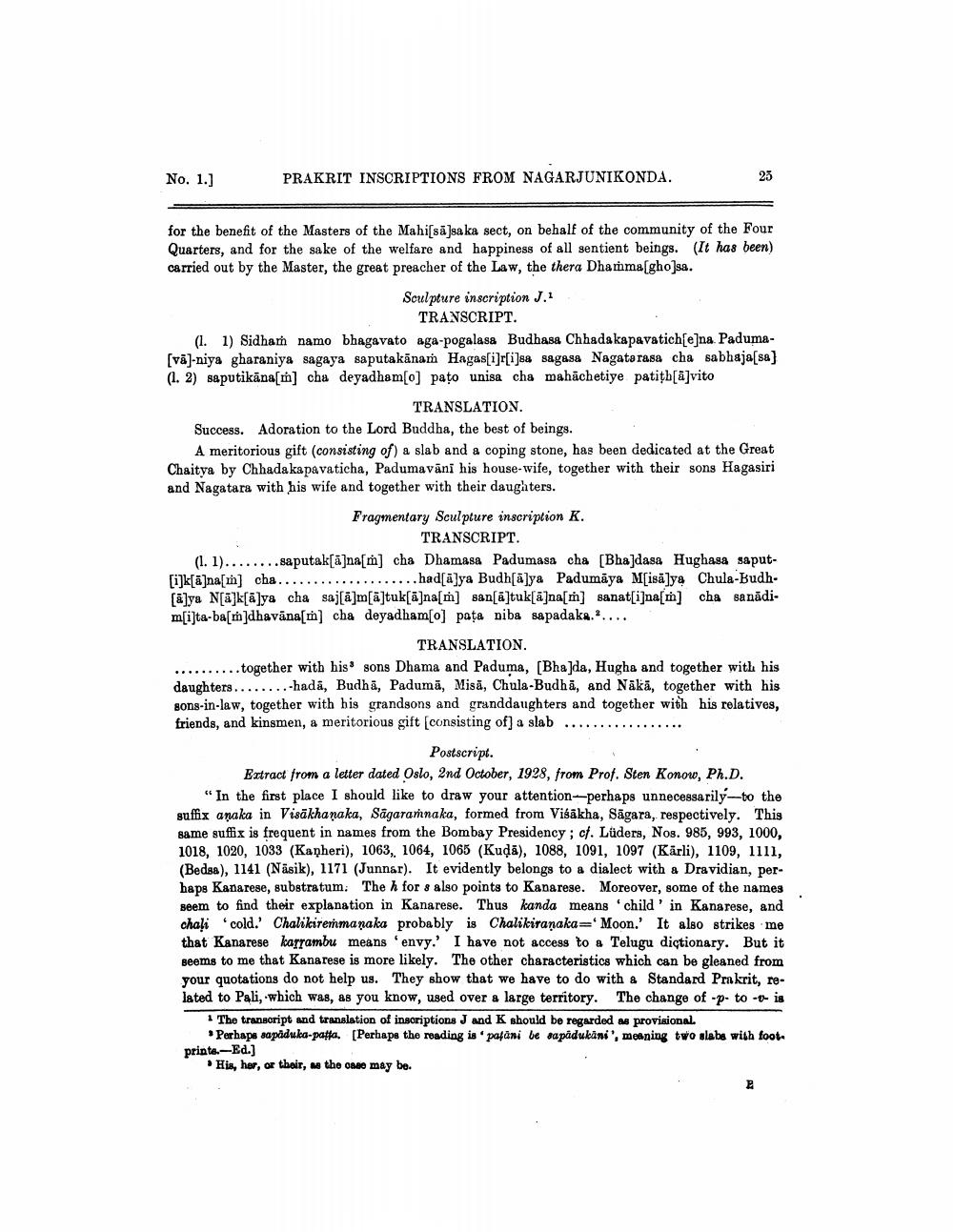________________
No. 1.]
PRAKRIT INSCRIPTIONS FROM NAGARJUNIKONDA.
for the benefit of the Masters of the Mahi[sa]saka sect, on behalf of the community of the Four Quarters, and for the sake of the welfare and happiness of all sentient beings. (It has been) carried out by the Master, the great preacher of the Law, the thera Dhamma[gho]sa.
Sculpture inscription J.1 TRANSCRIPT.
(1. 1) Sidham namo bhagavato aga-pogalasa Budhasa Chhada kapavatich[e]na. Paduma[va]-niya gharaniya sagaya saputakanam Hagas[i]r[i]sa sagasa Nagata rasa cha sabhaja[sa} (1.2) saputikāna[m] cha deyadham[o] pato unisa cha mahachetiye patiṭh[a]vito
25
TRANSLATION.
Success. Adoration to the Lord Buddha, the best of beings.
A meritorious gift (consisting of) a slab and a coping stone, has been dedicated at the Great Chaitya by Chhadakapavaticha, Padumavānī his house-wife, together with their sons Hagasiri and Nagatara with his wife and together with their daughters.
Fragmentary Sculpture inscription K. TRANSCRIPT.
(1. 1)........saputak[a]na[m] cha Dhamasa Padumasa cha [Bha]dasa Hughasa saput[i]k[a]na[m] cha.. ...had[a]ya Budh[a]ya Padumaya Misa]ya Chula-Budh[alya N[a]k[a]ya cha saj[a]m[a]tuk[a]na[m] san[a]tuk[a]na[m] sanat[i]na[m] cha sanadi. m[i]ta-ba[m]dhavana[m] cha deyadham[o] pata niba sapadaka.....
TRANSLATION.
....... together with his sons Dhama and Paduma, [Bha]da, Hugha and together with his daughters........-hada, Budha, Padumā, Misa, Chula-Budha, and Nākā, together with his sons-in-law, together with his grandsons and granddaughters and together with his relatives, friends, and kinsmen, a meritorious gift [consisting of] a slab
Postscript.
Extract from a letter dated Oslo, 2nd October, 1928, from Prof. Sten Konow, Ph.D.
"In the first place I should like to draw your attention-perhaps unnecessarily to the suffix anaka in Visakhanaka, Sagaramnaka, formed from Visakha, Sagara, respectively. This same suffix is frequent in names from the Bombay Presidency; cf. Lüders, Nos. 985, 993, 1000, 1018, 1020, 1033 (Kanheri), 1063,, 1064, 1065 (Kuḍā), 1088, 1091, 1097 (Karli), 1109, 1111, (Bedsa), 1141 (Näsik), 1171 (Junnar). It evidently belongs to a dialect with a Dravidian, perhaps Kanarese, substratum. The h for s also points to Kanarese. Moreover, some of the names seem to find their explanation in Kanarese. Thus kanda means 'child' in Kanarese, and chali 'cold.' Chalikiremmanaka probably is Chalikiranaka Moon.' It also strikes me that Kanarese karrambu means 'envy.' I have not access to a Telugu dictionary. But it seems to me that Kanarese is more likely. The other characteristics which can be gleaned from your quotations do not help us. They show that we have to do with a Standard Prakrit, related to Pali, which was, as you know, used over a large territory. The change of -p- to -v- is
1 The transcript and translation of inscriptions J and K should be regarded as provisional. Perhaps sapaduka-patta. [Perhaps the reading is 'pafani be sapadukani', meaning two slabe with footprints.-Ed.]
His, her, or their, as the case may be.
E




